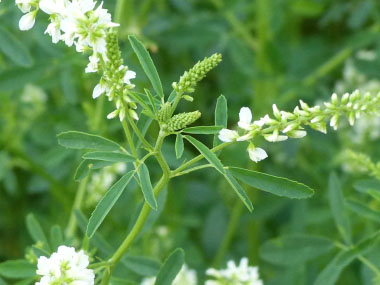White Sweet Clover: The Invasive Plant That's Taking Over
Title: White Sweet Clover: The Invasive Plant That's Taking Over
Introduction:
White sweet clover (Melilotus officinalis) is an invasive plant that is native to Europe and Asia. It was introduced to North America in the 17th century for cattle forage purposes, but it has since escaped cultivation and become a widespread problem. White sweet clover is a prolific seed producer, and its seeds can remain viable in the soil for up to 80 years. This makes it very difficult to control, and it has become a major threat to native plant communities in many parts of North America.
Main Content:
White sweet clover is a tall, herbaceous plant that can grow up to 2 meters in height. It has trifoliate leaves and small, white flowers that bloom in the spring and summer. The plant is a member of the legume family, and it fixes nitrogen in the soil. This makes it a valuable forage crop, but it also contributes to its invasiveness.
White sweet clover is an aggressive competitor, and it can quickly outcompete native plant species. It also produces allelopathic chemicals that can inhibit the growth of other plants. As a result, white sweet clover can have a significant negative impact on native plant communities.
In addition to its impact on plant communities, white sweet clover can also have a negative impact on wildlife. The plant provides food and shelter for some species of wildlife, but it can also displace native plant species that are important food sources for other animals. For example, white sweet clover has been shown to displace native prairie grasses that are important for grassland birds.
Control:
Controlling white sweet clover is a challenge, but there are a number of methods that can be used. One method is to manually remove the plants. This can be done by pulling the plants up by the roots, or by cutting them off at the base. However, this method can be labor-intensive and time-consuming, and it is not always effective.
Another method of control is to use herbicides. There are a number of herbicides that are effective against white sweet clover, but it is important to choose a herbicide that is safe for the environment. Herbicides should only be used as a last resort, and they should be applied carefully to avoid harming native plants.
A third method of control is to prevent the spread of white sweet clover. This can be done by cleaning equipment and vehicles that have been in contact with the plant, and by not planting white sweet clover seeds.
Conclusion:
White sweet clover is a serious invasive plant that is having a negative impact on native plant communities and wildlife. There are a number of methods that can be used to control white sweet clover, but it is important to choose a method that is appropriate for the situation. Prevention is the best way to control white sweet clover, and it is important to be aware of the plant and its potential impacts.
If you are interested in learning more about white sweet clover, I recommend visiting the Home Gardening. This website provides a comprehensive overview of the plant, including its history, uses, and potential side effects. You can also find information on how to identify white sweet clover in the wild.
FAQ of white sweet clover
- What is white sweet clover?
White sweet clover (Melilotus albus) is a perennial legume that is native to Europe and Asia. It is a valuable forage crop for livestock, and it is also used to make honey, essential oil, and herbal remedies.
- What are the benefits of white sweet clover?
White sweet clover has a number of benefits, including:
* It is a high-quality forage crop that is rich in protein and other nutrients.
* It is a good source of nectar for bees, which makes it a valuable crop for honey production.
* The essential oil from white sweet clover has a number of medicinal properties, including anti-inflammatory, antibacterial, and antiviral effects.
- How to grow white sweet clover?
White sweet clover is a relatively easy crop to grow. It prefers full sun and well-drained soil. It can be propagated from seed or by division.
- How to harvest white sweet clover?
White sweet clover can be harvested for forage when the flowers are just starting to bloom. It can also be harvested for seed when the pods are dry.
- What are the risks of growing white sweet clover?
White sweet clover is a relatively safe crop, but there are a few potential risks to be aware of:
* It can be invasive in some areas.
* It can harbor insects and diseases.
* The essential oil from white sweet clover can be toxic if ingested in large quantities.
Image of white sweet clover
- White sweet clover flowers in full bloom.
- A close-up of white sweet clover flowers.
- A field of white sweet clover in bloom.

- A bee collecting pollen from white sweet clover flowers.

- A leaf of white sweet clover.

- A stem of white sweet clover with leaves and flowers.

- A dried head of white sweet clover.

- A close-up of the seeds of white sweet clover.
- A white sweet clover plant in a pot.

- A white sweet clover tea bag.

Post a Comment for "White Sweet Clover: The Invasive Plant That's Taking Over"